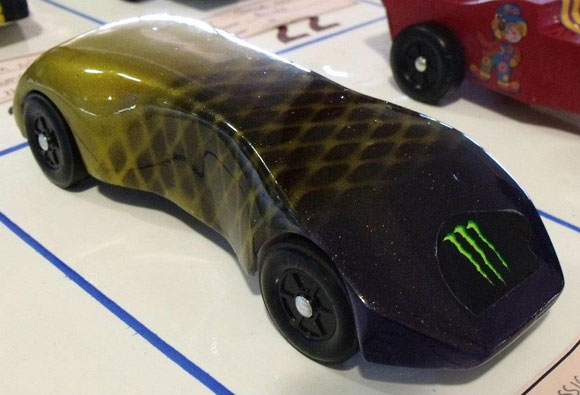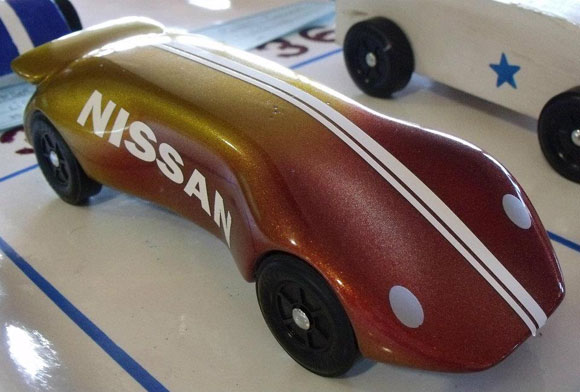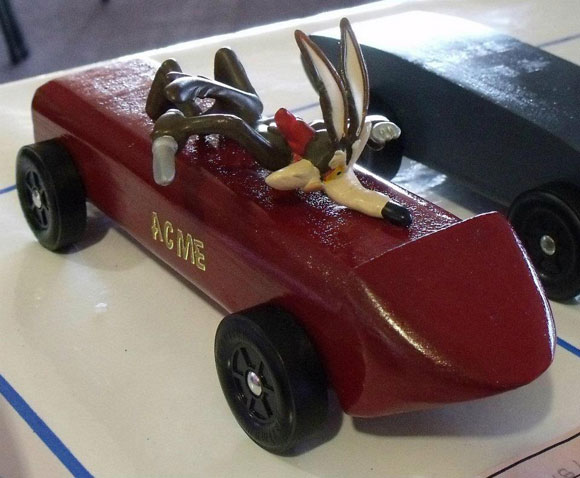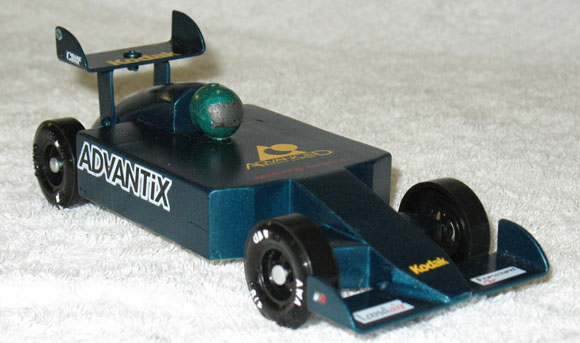– Feature Article – Runoffs: When and Why to Run Them
– Pinewood Derby Car Showcase
– Q&A
Feature Article
Runoffs – When and Why to Run Them
By Randy Davis
Years ago, virtually every pinewood derby race used an elimination method (usually double elimination) for running a pinewood derby race. This method was relatively easy to implement and easy to understand, but did have issues including:
- Slowest racers ran a few heats and were then eliminated (and likely lost interest in the event.
- Possible unfair trophy assignment (third fastest car is eliminated early due to repeated pairing with the fastest two cars).
- Cars did not always run on all lanes, so some cars had an advantage if they were assigned to a fast lane.
With the advent of Race Management software, many events have transitioned to a chart-based racing method, whereby all cars run the same number of heats, race in all lanes and are paired against a broad selection of other cars. These methods are much fairer, and are more accurate in assigning trophies.
But when using a chart-based method, the scoring method must be selected: time or points. I won’t get into a full comparison of time vs. points in this article.1 Time-based scoring is certainly popular and is really the best choice for large events. But for smaller events, I prefer point-based scoring. I believe this method keeps the audience more engaged, keeps each heat exciting, and makes the finish order of each heat important.
But with point scoring, the final trophy assignment may not be accurate after the heats are complete. Like elimination methods, random heat assignments can result in the third fastest car being relegated to fourth place.2 So, to ensure that trophies are assigned properly, another round for the fastest cars may be needed. Let’s look at when a second round is needed, and how many cars to select for the second round.
When Is A Second Round Required?
To answer this question, we must first understand the terms “Perfect- N” and “Partial Perfect-N” (PPN) as they apply to race charts.
A Perfect-N race chart is one in which every car races the same number of times in each lane, and races against every other car the same number of times.
The simplest case is 4 cars on a four lane track, racing one time per lane. Each car races one time in each lane, and in each heat races against the other 3 cars. Other cases of Perfect-N charts will be described below.
A PPN chart is one in which each car races the same number of times in each lane, and heat assignment is optimized so that no one car races against any other car more or less than one time greater than the average.
An example of a PPN chart is one with 8 cars on a four lane track, racing one time per lane. Since the example car will need to race against 12 other cars (3 per heat), and since seven (the original 8 cars minus the example car) doesn’t divide into 12 evenly, the example car will race against 7 cars one time and 5 cars a second time.
For a four lane track, Perfect-N charts exist for the following numbers of cars3:
4 – Yes
5 – Yes
6 – Yes – Bye required4
7 – Yes
8 – No
9 – No
10 – No
11 – No
12 – Yes – Bye required
13 – Yes
For all car counts greater than 13, only PPN charts exist.
When a race has a Perfect-N chart the race is perfectly fair and a run-off is not needed (except in the case of tie). But if the race has a PPN chart, it is possible that a trophy may be incorrectly assigned. In this case, a run-off race is required.
HOW MANY CARS SHOULD BE IN THE SECOND ROUND?
From the above discussion, the answer is clearly that a number must be selected that has a Perfect-N chart. In no case should a second round use a PPN chart.
Typically, we select the top seven cars, except when there are ties that would drive the number beyond seven. Then we select the top five or six cars.
Implementation / Conclusion
I grant that a time-based race is easier to implement, as the need for a second round is not necessary. But with a modern race management application, such as Grand Prix Race Manager, creating a second round is quite easy. In our race, we typically have the second round ready to go in two minutes from the completion of the final heat of round 1. Our emcee fills the time with a few kid-friendly jokes, so the excitement of the event continues during this slight delay. Then during the second round (seven cars typically take less than ten minutes), the excitement level (and sound level) reaches its peak.
If you are currently using a time-based method for your small race, consider switching to a point-based method. I believe you will generate greater interest and excitement, for just a few extra minutes of event time.
1For a comparison of these two methods, please refer to: Points or Times: Which Method Should I Use?
2For example, if the third fastest car races the two fastest cars resulting in two second place finishes, and the fourth fastest car only races against one of the top three cars resulting in one second place finish, then the fourth fastest car would be incorrectly assigned the third place trophy.
3If you have a track with more or less than four lanes, you can use Grand Prix Race Manager (GPRM) to determine the Perfect-N charts.
4A phantom car is inserted into the schedule. When it races, the lane is left empty. GPRM automatically takes care of byes.
Pinewood Derby Car Showcase
Here are some cars from the “Wood and Wheels” race held in Australia (Maximum Velocity supplies the wheels and axles for the race). The photos were submitted by Matthew Webb.
Also, a Formula One Awana car built by Matthew:
Q&A
Last year I used full-weight BSA wheels and we easily took first place. This year, I used weight-reduced wheels. We still took first place, but it was a tight race. Why would that be? Aren’t lighter weight wheels faster?
Lighter wheels are faster, all else being equal. There are many things that could have been different the second year that were out of your control (track setup differences – levelness, location; better competition; staging, etc.). So it is hard to say what happened. You would have to run the two cars side by side on the same track to see which was really faster.
Personally, I would always use light-weight wheels if legal for the race.
Want Answers?
Do you have a pinewood derby-related question? If so, e-mail us your question.We answer all questions by e-mail, but not every question will appear in the Q&A section of the newsletter.
Back Issues
Are you a new subscriber, or have you missed some of the previous newsletters? Don’t miss out; all of the issues for Volume 5 through Volume 17 are posted on our web site.
Newsletter Contributions
We welcome your contributions. If you would like to contribute an article, a web site review, a speed tip, or a pinewood derby memory, please e-mail us.
Subscription Information
The Pinewood Derby Times is a free e-newsletter focused on pinewood derby racing. It is published biweekly from October through March.
If you haven’t already done so, please forward this issue to your pinewood derby friends. But please don’t subscribe your friends. Let them decide for themselves. Thanks.
If this newsletter was forwarded to you, why not subscribe to receive this newsletter. There is no cost, and your e-mail address is safe, as we never sell or share our distribution list.
To subscribe, send a blank e-mail to
[email protected]
You will receive a confirmation e-mail. Reply to the confirmation e-mail and you will start receiving the Pinewood Derby Times with the next issue.
Randy Davis, Editor, Pinewood Derby Times
E-Mail: [email protected]
(C)2018, Maximum Velocity, Inc. All rights reserved. Please do not reprint or place this newsletter on your web site without explicit permission. However, if you like this newsletter we grant permission, and encourage you to e-mail it to a friend.
Maximum Velocity disclaims any personal loss or liability caused by utilization of any information presented in this newsletter.
The Pinewood Derby Times is not specific to, and is not affiliated with the Boy Scouts of America, YMCA, Awana, or any other organization.
(R)Maximum Velocity is a registered trademark of Maximum Velocity, Inc.
(R)Pinewood Derby is a registered trademarks of the Boys Scouts of America.
(R)Awana is a registered trademark of Awana Clubs International.
All other names are trademarks of their respective owners.




